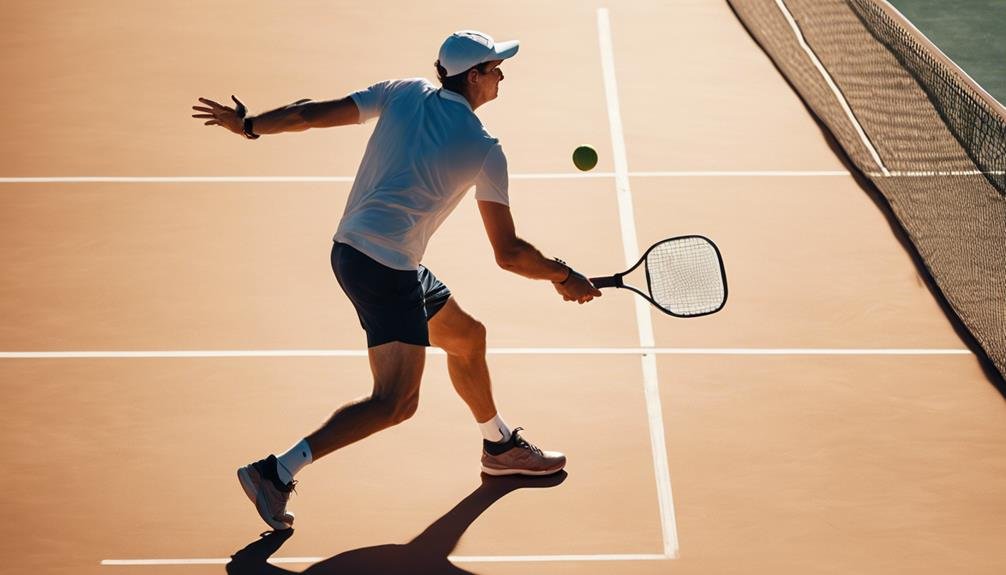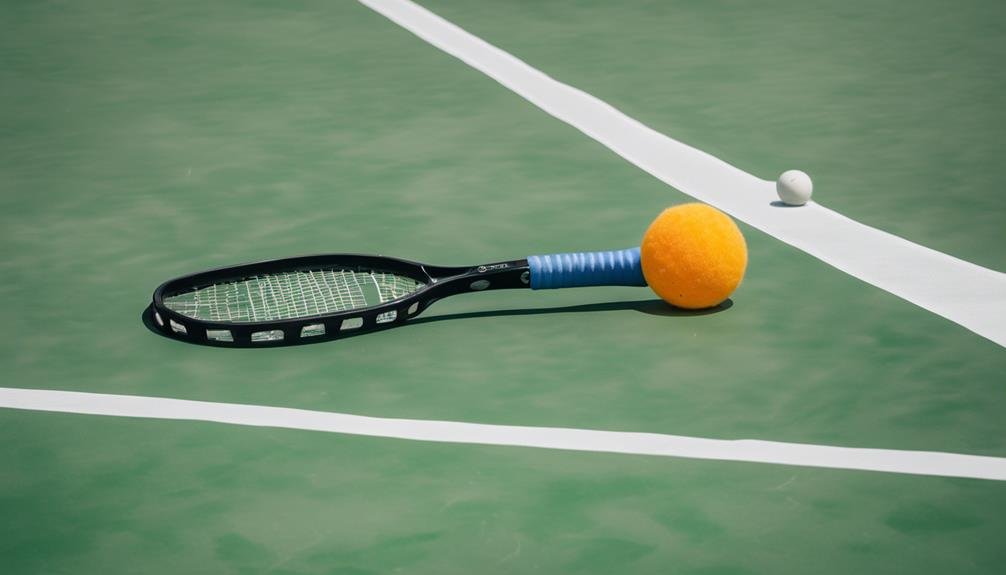To master the art of pickleball and play like a pro, it is crucial to understand the basic rules and fundamentals of the game. This includes developing court vision, efficient footwork, and proficiency in serves, volleys, and groundstrokes. Advanced spin techniques such as cut returns and topspin volleys can help improve ball control and create more aggressive shots. Strategic court positioning, effective communication with your partner, and a solid serving strategy also enhance gameplay. By analyzing and improving all aspects of your performance, you can overcome common faults and elevate your skills.
Key Takeaways
- Mastering groundstrokes empowers players with power and precision, executed from the backcourt for strategic shots.
- Volleys, shots played in mid-air, demand quick reflexes and finesse, crucial for controlling the game's pace and direction.
- Developing proper grip, stance, and footwork is key to establishing a strong foundation in pickleball.
- Effective court positioning and strategic shot selection are critical for outmaneuvering opponents and commanding the court.
Mastering Pickleball Fundamentals

Mastering Pickleball Fundamentals
Mastering pickleball fundamentals starts with understanding the core principles of the game, encompassing the layout of the court, basic rules like the 'double bounce,' and effective techniques for serves, volleys, and groundstrokes. A solid grasp of these basics sets the stage for significant improvement.
Developing court vision and improving footwork are critical elements in this process. Court vision involves anticipating your opponent's shots and positioning yourself strategically to respond effectively. Efficient footwork enables you to cover the court quickly and maintain optimal positioning, ensuring that you can reach and return shots with ease.
To enhance your pickleball game, focus on deepening your understanding of key shots. The serve, for instance, requires careful placement and power control to limit the opponent's options. Volleys, in particular, are pivotal for directing the ball from the kitchen line with precision. Meanwhile, effective groundstrokes allow you to hit consistent, well-placed shots that challenge your opponent. By dedicating time to mastering these rudimentary skills, you will lay a strong foundation for progressing to more advanced strategies and taking your game to the next level.
Advanced Spin Techniques Explained
Building upon a solid foundation of core fundamentals, incorporating advanced spin techniques can significantly amplify the complexity and potency of your pickleball game by allowing you to better control the ball's trajectory and bounce. Not only does mastering advanced spin tactics enrich your overall playing style, but it also yields valuable opportunities to outmaneuver your opponents.
Advanced Spin Techniques for Enhanced Play
- Cut Returns: Techniques like the cut return offer better ball control by applying underspin, slowing the ball's bounce and making it more manageable for volleys.
- Topspin Volleys: Utilizing topspin while volleying generates a faster and more aggressive shot, pushing your opponent back and limiting their response options.
- Dinking Strategies: Incorporating spin into dinks can alter the pace and angle of the ball, making it difficult for opponents to predict and react.
Adapting to various spin tactics can dramatically improve your game by adding depth and flexibility to your shots, ultimately transforming you into a formidable pickleball player.
Effective Court Positioning Strategies

Effective Court Positioning Strategies
To maximize effectiveness in pickleball, it is crucial to optimize court positioning by strategically allocating space, controlling angles, and leveraging quick reactions to anticipate and respond to your opponents' moves. Developing court positioning awareness allows you to command the court and make smart decisions to outmaneuver your opponents.
Strategic footwork is key to maintaining effective court positioning and involves dividing the court into thirds, with the middle third being the most important to cover. By focusing on this central area, you gain maximum angle options and control over the game.
Maintaining proper positioning allows you to manage the pace of the game and keep your opponents on their heels. Effective court positioning requires you to be aware of your partners' positions and adjust your movements accordingly to ensure seamless coverage.
Boosting Your Serving Game
To explosive commence a pickleball game, employ a robust serving strategy to immediately impose your will on the match, forcing opponents to react and setting the tone for a dominant performance.
When enhancing your serving technique, consider these key points for rapid improvement:
- Emphasize depth over speed: Focus on hitting serves deep into your opponent's court rather than solely relying on speed. This strategy will lead to more uncomfortable returns and increased opportunities to gain an advantage.
- Use a precise pre-serve routine: Maintain a consistent preparation process before each serve to ensure consistency and precision.
- Timing is everything: Perfect your timing for the serve release to execute a seamless and powerful serve.
Overcoming Common Faults

To elevate your pickleball game, it's essential to identify and address common faults that hinder your performance.
Balancing power and control, improving ball perception, and enhancing communication are key areas to focus on, as they can significantly impact your overall gameplay.
Balance Power & Control
Mastering the delicate balance between power and control is crucial in pickleball. A well-crafted paddle must strike the ideal balance between generating forceful shots and maintaining precision. This balance significantly impacts your overall gameplay, affecting your ability to hit consistent shots and make strategic decisions during a match.
To strike this balance effectively, consider the following key factors:
- Paddle Weight: Heavier paddles provide more power but may sacrifice control, while lighter paddles offer greater maneuverability but potentially less force.
- Weight Distribution: Paddles with weight concentrated towards the head generate more power, whereas evenly distributed weight enhances control and stability.
- Grip Size and Shape: Ensure your grip size is comfortable and allows for precise control.
Improve Ball Perception
Pickleball success relies heavily on the ability to accurately perceive the ball's trajectory and speed, which demands both effective paddle control and sharp visual acuity. Inherently, this is a visual sport where the connection between your eyes and reactions is paramount.
As you track the ball, hundreds of times a week, your vision becomes critical to your performance on the court. To excel, you need to fine-tune your perception by recognizing the ball's speed, projected depth, and rotation. This is not just about getting your vision to 20/20; it is about strengthening your eye-hand coordination and quickening your reaction time.
Fortunately, vision can be improved through targeted training. Programs like Vizual Edge, used by top athletes in visually demanding sports, strengthen the muscles in your eyes and expedite the connection between visual signals and reactions.
Enhance Communication
Pickleball Lessons: Enhance Communication
Effective communication, often overlooked but vital to pickleball success, is achieved by recognizing and addressing common faults in your interaction with your partner. Imperative for a cohesive team effort.
Recognize and Adapt: Identify your partner's strengths and weaknesses to tailor your communication. Adapt to any limitations to ensure mutual support.
Encourage Open Feedback: Emphasize the value of speaking freely and constructively in various situations during the game.
Improve Body Language: Vision on the court and non-verbal cues can lead to better coordination and anticipation.
Develop Listening Skills: Attune yourself to your partner's every suggestion or instruction, ensuring seamless team play.
This enhanced communication fosters a more cooperative and successful partnership, essential for winning matches and building lasting relationships on the pickleball court.
Understanding Scoring Systems
Understanding scoring systems in pickleball is a critical aspect of mastering the game, as it determines the ultimate outcome of each match. The basic scoring rules in pickleball involve points being scored only by the serving side. The game begins with the player on the right side of the court (even court) serving, and after a point is scored, the server moves to the other side. If the serving side loses a rally, the serve rotates to the other team. The score is typically called as three numbers: server score, receiver score, and server number (1 or 2).
To gain an edge, recognizing scoring landmarks and tracking game momentum are crucial. Singles and doubles scoring differ slightly, with singles scoring following similar rules as doubles but without a second server. It is essential to understand these scoring specifics to make strategic decisions during gameplay. Familiarity with the scoring system can significantly enhance one's pickleball skills, ultimately contributing to a more engaging and successful playstyle.
Beginning With the Basics

Mastering the fundamentals of pickleball is a crucial step in developing a strong foundation for a successful and enjoyable playing experience.
As a beginner, it is essential to focus on the basics, including hand-eye coordination, movement patterns, and basic rules.
Advanced Strategies for Success
To elevate your game to the next level, incorporating advanced strategies such as deliberate court positioning, effective use of the non-volley zone, and strategic shot selection is crucial.
A strategic mindset is essential for success in pickleball. Developing the ability to read your opponent's game and adapt accordingly is vital. This involves understanding their strengths, weaknesses, and tendencies to create opportunities for counterplay.
Effective use of the non-volley zone (NVZ) is also critical, as it provides a significant advantage in controlling the pace and direction of the game. This zone necessitates precise positioning and shot selection to ensure volleys are made outside the zone, maintaining a clear advantage.
Tournament preparation involves a combination of skills practice and strategic planning. Developing a game plan with your partner, knowing when to call timeouts, and managing errors effectively can make a significant difference in performance. Keeping the ball in play and focusing on hitting to the middle of the court can also provide a competitive edge.
Enhancing Your Backhand Shots

To elevate your pickleball game, mastering your backhand shots is crucial. Focusing on effortless backspin shots requires precise grip control and technique alignment, which significantly improves your shot's consistency and authority.
Effortless Backspin Shots
Transforming your backhand into a powerful asset requires grasping the nuances of different shots, including the often-challenging backspin slice, which can significantly enhance your opponents' returns and overall control. Generating lobs effectively involves mastering the backspin slice, as it adds an extra layer of complexity for your opponents to handle.
To produce effortless backspin shots, follow these key strategies:
- Master the Grip: Use the high Continental grip to ensure proper paddle control.
- Control Your Body Position: Maintain a neutral stance and rotate your body correctly to generate power.
- Understand Spin: Recognize the difference between topspin and backspin and how to use them effectively.
Mastering the Grip
Mastering the Grip
The key to unlocking a powerful backhand shot in pickleball lies in the mastery of the backhand grip, which sets the foundation for a precise and controlled shot.
A proper grip technique is crucial in ensuring precision and control over the ball during backhand shots. Proper hand positioning is essential, with the palm facing downwards and the wrist slightly bent, allowing for optimal flexibility and power.
Maintaining a light grip pressure, equivalent to 3-4 out of 10, allows for better control and sensitivity in shots.
Optimizing Your Forehand Shots
Optimized forehand shots in pickleball require a perfect blend of proper stance, grip, swing technique, and body rotation to unleash maximum power and control. Developing a consistent forehand shot involves detailed attention to each of these critical components.
Proper Foot Placement: Stand at a 45-degree angle to the net with your feet shoulder-width apart. This positioning allows for smooth body rotation and efficient power transfer.
Incorporating Paddle Angles: Experiment with different paddle angles to vary your shot trajectories. Angling your paddle slightly towards the net produces a softer, higher arc, while holding it straight generates a lower, more aggressive shot.
Supination of the Forearm: Rotate your forearm to generate power and control. Supination keeps your wrist straight, ensuring accurate and consistent shots.
Practice Drills: Regularly practice your forehand with a variety of drills to achieve muscle memory. Focus on perfecting both short and long shots in different scenarios.
Expert Routines for Performance

Elite pickleball players rely on targeted exercise routines to enhance their performance, emphasizes certified specialists like Dustin Davis, who stresses the importance of integrating strength and flexibility exercises to prevent injuries and enhance on-court agility.
A well-rounded fitness regimen must include resistance training, which is essential for building endurance and resilience to injury. As demonstrated in research with over 90,000 participants, incorporating resistance training at least twice a week can lead to a significant reduction in all-cause mortality while enhancing overall well-being.
Moreover, nutrition plays a pivotal role in maintaining peak performance. A balanced diet rich in carbohydrates for energy and protein for muscle building is crucial. Timing is also important: eat the right foods at the right times to avoid fatigue and optimize performance on the court.
By combining these routines, players can significantly improve their mental focus and overall game. Pro players like Tyson McGuffin underscore the importance of footwork drills and forehand techniques to dominate the competition.
With dedication to a comprehensive training program, you can unlock your potential and play like a pro. Strengthen your foundation, refine your strategies, and elevate your pickleball experience.
Conclusion
Mastering the art of pickleball requires dedication and a deep understanding of various techniques.
Key fundamentals include proper serves, effective return shots, and strategic net play.
Advanced tactics involve incorporating spins to deceive opponents. Players must master positional awareness to optimize shots and avoid errors.
Effective backhand and forehand shots, along with intelligent serving strategies, are crucial for success.
Expert routines enhance performance and inspire a pickleball lifestyle.

